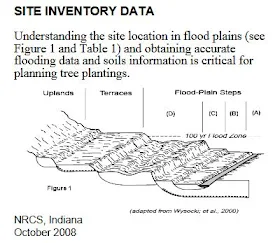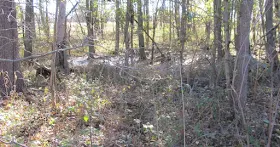If you spend much time in my part of the world you will soon figure out that much of the land that is in "woods" is too wet to plow. The farmer did not allow trees to grow out of a sense of environmental stewardship. Rather, he let them grow because he could not profitably do otherwise.
The other thing you will notices is that those wet spots are dominated by two species, Silver Maple (known colloquially as 'soft maple') and ash trees. Most of the ash trees are now dead.
You will find the occasional elm tree living on borrowed time. In a few rare, undisturbed locations you will find tamarack or sycamore or swamp white oak or burr oak. The thing about Michigan is that we do not have nearly the richness of species found farther south, down in the Ohio river valley.
The risks of mono-cultures are well documented. I am always on the look-out for new species to backstop the soft maples and dead ash in local woods that are subject to flooding.
Indiana
 |
| Step (A) is frequently flooded for up to 15 days. Step (B) is under water for up to 7 days. Step (C) is only occasionally flooded |
 |
| The planting location (step) is one of the middle columns on this table. The pH range is on the extreme right. |
Black Gum, Cottonwood, Coffeetree, Bur Oak, Pin Oak, and River Birch are listed as able to survive 7 days of flooding.
Firewood
At 33lbs/cubic foot, dry Soft Maple is only a middling wood for burning. One of the tricks is to get it dry.
Using Soft Maple as the basis, Ash is 25% better than dry Soft Maple. The thing about Ash is that it carries very little water and dries lickity-split. Most wood burners will tell you that Ash is at least twice as good as Soft Maple.
European Alder, one of the few wetland trees that can fix nitrogen is 6% less dense than Soft Maple.
Sycamore and Sweetgum are nearly identical to Soft Maple with respect to wood density.
Black Gum and River Birch are about 15% more dense than Soft Maple.
Oak is about 35% more dense.
Pecan and Honey Locust are about 40% denser.

Any recommendation for a tree or other vegetation type to suck up water pooling between two houses after heavy rainfalls?
ReplyDeleteI think you are skewed if you want something that will sponge up water quickly. They just cannot transpire water that quickly, especially if the air is humid.
DeleteOne option would be to design a swale (details on the web). In a nutshell, you fill the low spot with wood chips so the pond is buried and you plant ornamental plants like Ilex verticillata. If you don't care for your neighbor, Poison Sumac is very ornamental.
https://www.nrcs.usda.gov/Internet/FSE_DOCUMENTS/nrcs144p2_030196.pdf
ReplyDeleteI like the ph chart.
https://acornsandchestnuts.blogspot.com/2014/01/starhill-forest-arboretum.html
ReplyDelete"Regarding the flood tolerance ratings, consider moving Q. bicolor to the most tolerant category and Q. muehlenbergii to the intermediate category. "
Q bicolor is a tolerant oak per the above.
Bald Cypress can live in standing water, and it's a tough wood!
ReplyDeleteThe soft Maple you mention that dries slowly - is that wood that is hard to split and is very stringy or fibrous inside?
ReplyDeleteUsually easy to split. Straight grain. Very few in-grown twigs. Rots fast so you don't have the option of leaving it in the woods for extended periods, i.e. years.
DeleteI hope this pastes in the box. I wrote a lot of CRP plans for landowners. I broke our sites down to four main types in the Clay Pan area of Southern Illinois. Riparian sites along the Wabash bottoms were a bit more complex to figure out, and every time I got a case there I was writing more soil descriptions. I quit using white pine for spacers when the Illinois deer herd was peaking out. Deer will walk down a row of trees and clip or pull every pine. Baldcypress is a good spacer on nearly any site, and it will sprout back if it is cut off by wildlife. I haven't sat down with my dendro book yet to study range maps, but will do that and get back to you.
ReplyDeleteUpland Sites: black cherry, red-cedar, white pine, red pine, white oak, black oak, persimmon, tulip-poplar, dogwood, redbud, plum, elderberry, hawthorn, smooth/shining/staghorn sumac; plus all bottomland species.
Side Slopes: Upland species; bottomland species; and if the slope is north or east facing, northern red oak, Shumard oak, and black walnut.
Riparian Zones: Bottomland species; and black walnut, Shumard oak, cherrybark oak.
Bottomland Sites: Pecan, hackberry, bur oak, shellbark hickory, baldcypress, sweetgum, pin oak, persimmon, river birch, sycamore, swamp white oak, nuttal oak, overcup oak, swamp chestnut oak, willow oak, red maple, and cottonwood.
Ash species are no longer recommended because of the Emerald Ash Borer. Use cypress, sweetgum, birch, sycamore, cottonwood, silver maple, and red maple for spacer/trainer trees instead of ash.
Black walnut will grow on uplands, but will not always perform well for timber production. The wildlife value of walnut remains on less-than-ideal sites.